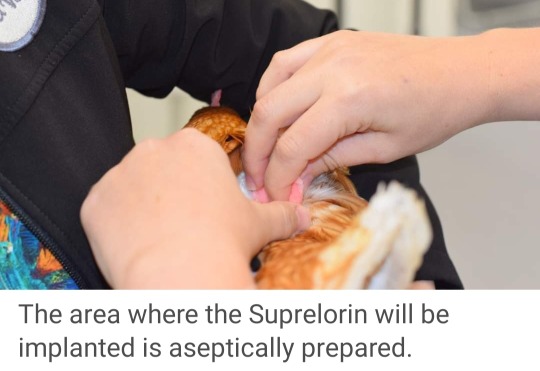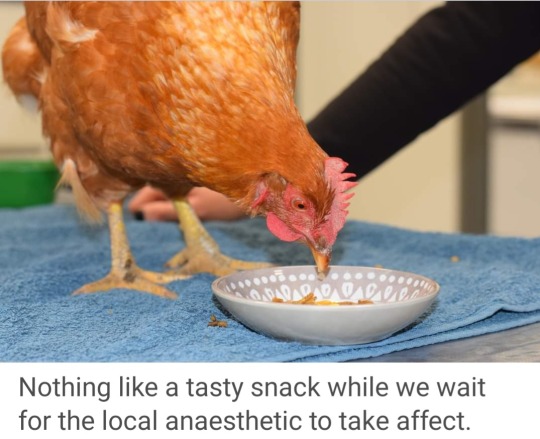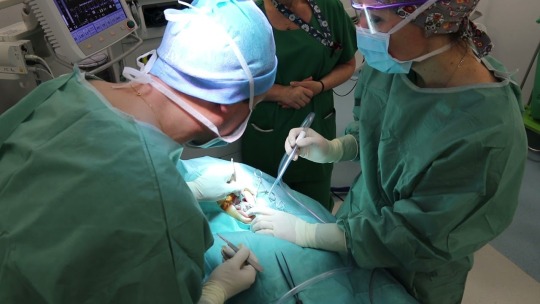#medical implants
Text
I think this one is pretty important, folks. UK ppl please sign. Others, please boost!
It's frankly nightmarish how manufacturers of medical implants operate!
We believe it should be made illegal for manufacturers of medical devices implanted into patients to regularly charge the patient for upgrades or maintenance.
We also believe it should be a legal requirement that if the manufacturer goes out of business, all the Intellectual Property (IP) - both hardware and software - for the device must be made public.
We believe no one, and no company, should be allowed to essentially charge rent for any implant that is placed inside a person's body, and people should not be left with a device that cannot be maintained if its manufacturer goes bankrupt.
265 notes
·
View notes
Text
Orphaned neurological implants

The startup world’s dirty not-so-secret is that most startups fail. Startups are risky ventures and their investors know it, so they cast a wide net, placing lots of bets on lots of startups and folding the ones that don’t show promise, which sucks for the company employees, but also for the users who depend on the company’s products.
You know what this is like: you sink a bunch of time into familiarizing yourself with a new product, you spend money on accessories for it, you lock your data into it, you integrate it into your life, and then, one morning — poof! All gone.
Now, there are ways that startups could mitigate this risk for their customers: they could publish their source code under a free/open license so that it could be maintained by third parties, they could refuse to patent their technology, or dedicate their patents to an open patent pool, etc.
All of this might tempt more people to try their product or service, because the customers for digital products are increasingly savvy, having learned hard lessons when the tools they previously depended were orphaned by startups whose investors pulled the plug.
But very few startups do this, because their investors won’t let them. That brings me to the other dirty not-so-secret of the startup world: when a startup fails, investors try to make back some of their losses by selling the company’s assets to any buyer, no matter how sleazy.
A startup’s physical assets are typically minimal: used ergonomic chairs and laptops don’t exactly hold their value, and there’s not much of a market for t-shirts and stickers advertising dead businesses.
Wily investors are more interested in intangible assets: user data and patents, which are sold off to the highest bidder. That bidder is almost certainly a bottom-feeding scumbag, because the best way to maximize the value of user data is to abuse it, and the best way to maximize a failed business patent is to use it for patent trolling.
If you let your investors talk you into patenting your cool idea, there’s a minuscule chance that the patent will be the core of a profitable business — and a much larger chance that it end up in a troll’s portfolio. Real businesses make things that people want. Patent trolls are parasites, “businesses” whose only products are legal threats and lawsuits, which they use to bleed out real businesses.
The looming threat of dissolution gives rise to a third startup dirty secret: faced with a choice of growth or sustainability, companies choose growth. There’s no point in investing in sustainability — good information security, robust systems, good HR — if it costs you the runway you need to achieve liftoff.
Your excellent processes won’t help you when your investors shut you down, so a “lean” startup has only the minimum viable resiliency and robustness. If you do manage to attain liftoff — or get sold to a Big Tech firm — then you can fix all that stuff.
And if the far more likely outcome — failure — comes to pass, then all the liabilities you’ve created with your indifferent security and resiliency will be someone else’s problem. Limited liability, baby!
Combine these three dirty secrets and it’s hard to understand why anyone would use a startup’s product, knowing that it will collect as much data as it can, secure it only indifferently, and sell that data on to sleazy data-brokers. Meanwhile, the product you buy and rely upon will probably become a radioactive wasteland of closed source and patent trolling, with so much technology and policy debt that no one can afford to take responsibility for it.
Think of Cloudpets, a viral toy sensation whose manufacturer, Spiral Toys, had a successful IPO — and then immediately started hemorrhaging money and shedding employees. Cloudpets were plush toys that you connected to your home wifi; they had built-in mics that kids could activate to record a voice-memo, which was transmitted to their parents’ phones by means of an app, and parents could send messages back via the toys’ speakers.
But Spiral Toys never bothered to secure those voice memos or the system for making new ones. The entire database of all recordings by kids and parents sat on an unencrypted, publicly accessible server for years. It was so indifferently monitored that no one noticed that hackers had downloaded the database multiple times, leaving behind threats to dump it unless they were paid ransoms.
By the time this came to light, Spiral Toys’ share price was down more than 99% and no one was answering any of its email addresses or phones. The data — 2.2 million intimate, personal communications between small children and their parents — just hung out there, free for the taking:
https://www.troyhunt.com/data-from-connected-cloudpets-teddy-bears-leaked-and-ransomed-exposing-kids-voice-messages/
Data leakage is irreversible. Those 2,200,000 voice memos are now immortal, child-ghosts that will haunt the internet forever — after the parents are dead, after the kids are dead.
Data breaches are permanent. Filling a startup’s sandcastle with your important data is a high-risk bet that the company will attain liftoff before it breaches.
It’s not just your data that goes away when a startup folds — it’s also the money you invest in its hardware and systems, as well as the cost of replacing devices that get bricked when a company goes bust. That’s bad enough when it’s a home security device:
https://gizmodo.com/spectrum-kills-home-security-business-refuses-refunds-1840931761
But what about when the device is inside your body?
Earlier this year, many people with Argus optical implants — which allow blind people to see — lost their vision when the manufacturer, Second Sight, went bust:
https://spectrum.ieee.org/bionic-eye-obsolete
Nano Precision Medical, the company’s new owners, aren’t interested in maintaining the implants, so that’s the end of the road for everyone with one of Argus’s “bionic” eyes. The $150,000 per eye that those people paid is gone, and they have failing hardware permanently wired into their nervous systems.
Having a bricked eye implant doesn’t just rob you of your sight — many Argus users experience crippling vertigo and other side effects of nonfunctional implants. The company has promised to “do our best to provide virtual support” to people whose Argus implants fail — but no more parts and no more patches.
Second Sight wasn’t the first neural implant vendor to abandon its customers, nor was it the last. Last week, Liam Drew told the stories of other neural abandonware in “Abandoned: the human cost of neurotechnology failure” in Nature:
https://www.nature.com/immersive/d41586-022-03810-5/index.html
Among that abandonware: ATI’s neural implant for reducing cluster headaches, Nuvectra’s spinal-cord stimulator for chronic pain, Freehand’s paralysis bypass for hands and arms, and others. People with these implants are left in a precarious limbo, reliant on reverse-engineering and a dwindling supply of parts for maintenance.
Drew asked his expert subjects what is to be done about this. The least plausible answer is to let the market work its magic: “long-term support on the commercial side would be a competitive advantage.” In other words, wait for companies to realize that promising a durable product will attract customers, so that the other companies go out of business.
A better answer: standardization. “If components were common across devices, one manufacturer might be able to step in and offer spares when another goes under.” 86% of surgeons who implant neurostimulators back this approach.
But the best answer comes from Hunter Peckham, co-developer of Freehand and a Case Western biomedical engineer: open hardware. “Peckham plans to make the design specifications and supporting documentation of new implantable technologies developed by his team freely available. ‘Then people can just cut and paste.’”
This isn’t just the best answer, it’s the only one. There’s no ethical case for permanently attaching computers to people’s nervous systems without giving them the absolute, irrevocable right to nominate who maintains those computers and how.
This is the case that Christian Dameff, Jeff Tully and I made at our Defcon panel this year: “Why Patients Should Hack Medtech.” Patients know things about their care and their needs that no one else can ever fully appreciate; they are the best people to have the final say over med-tech decisions:
https://www.youtube.com/watch?v=_i1BF5YGS0w
This is the principle that animates Colorado’s HB22–1031, the “Consumer Right To Repair Powered Wheelchairs Act,” landmark Right to Repair legislation that was signed into law last year:
https://www.eff.org/deeplinks/2022/06/when-drm-comes-your-wheelchair
Opponents of this proposal will say that it will discourage investment in “innovation” in neurological implants. They may well be right: the kinds of private investors who hedge their bets on high-risk ventures by minimizing security and resilience and exploiting patents and user-data might well be scared off of investment by a requirement to make the technology open.
It may be that showboating billionaire dilettantes will be unwilling to continue to pour money into neural implant companies if they are required to put the lives of the people who use their products ahead of their own profits.
It may be that the only humane, sustainable way to develop neural implants is to publicly fund that research and development, with the condition that the work products be standard, open, and replicable.
Image:
Cryteria (modified)
https://commons.wikimedia.org/wiki/File:HAL9000.svg
CC BY 3.0
https://creativecommons.org/licenses/by/3.0/deed.en
[Image ID: The staring eye of HAL9000 from 2001: A Space Odyssey. Centered in it is a medieval anatomical engraving of the human nervous system, limned in a blue halo.]
#pluralistic#neurology#medtech#unauthorized bread#body horror#regulatory capture#bodily autonomy#floss#medical implants
105 notes
·
View notes
Text
Surgery went well. Had a scare that meant I had to go to the ER to get it checked out to be sure, but it turned out okay (body cannot help but be dramatic, I guess lol) and the ER staff was very kind about it. Very excited to have my implant installed and working already. It's such a relief to have my body a bit more functional and easier to manage even with the current post-surgical pain.
5 notes
·
View notes
Text
Every person with a uterus needs to watch The Bleeding Edge on Netflix
2 notes
·
View notes
Text
3D Printed Medical Implant Market Analysis, Market Size, In-Depth Insights, Growth and Forecast 2030

Global 3D printed medical implants market is set for remarkable expansion, with revenue expected to soar from US$585.8 million in 2023 to an estimated US$1,511.1 million by 2030. This surge reflects the growing adoption of 3D printing technology across various medical specialties, offering unparalleled precision and customisation in patient care.
For more information: https://www.fairfieldmarketresearch.com/report/3d-printed-medical-lmplant-market
Market Overview: The 3D printed medical implant market has witnessed significant growth, fuelled by advancements in additive manufacturing technologies. These innovations have led to the creation of implants with unprecedented precision and complexity, enhancing treatment outcomes across orthopedics, craniofacial reconstruction, and dental prosthetics.
Key Growth Determinants:
Advancements in Additive Manufacturing Technologies: Ongoing research and development have improved printing techniques, enabling the fabrication of implants that closely resemble real anatomical features. This increased accuracy enhances patient outcomes and allows for specialised care in complicated medical cases.
Customisation and Personalisation Trends: The emphasis on customised healthcare solutions has driven the adoption of 3D printed medical implants, offering implants tailored to each patient's unique anatomy. This trend reduces the risk of complications, increases patient satisfaction, and improves treatment efficacy.
Rising Incidence of Chronic Diseases: The global increase in orthopedic illnesses and chronic diseases drives the demand for 3D printed medical implants. These implants provide flexible solutions tailored to individual patient needs, addressing conditions such as osteoarthritis, osteoporosis, and severe injuries.
Major Growth Barriers:
Regulatory Challenges: Complex regulatory environments and rigorous certification procedures hinder the swift commercialisation of 3D printed medical implants, limiting market growth and delaying the assimilation of novel solutions into conventional healthcare procedures.
Material Limitations: Despite technological breakthroughs, material constraints pose challenges in ensuring biocompatibility and longevity of 3D printed implants, slowing down the introduction of innovative solutions and hindering market growth.
Key Trends and Opportunities:
Personalised Implants Gaining Traction: The growing popularity of customised healthcare solutions drives the expansion of the 3D printed medical implant market, with companies investing in cutting-edge imaging tools and software to design accurate implants tailored to each patient.
Expansion of 3D Printing Materials and Technologies: Ongoing developments in biocompatible and bioresorbable materials, along with advancements in printing processes, present opportunities for market expansion and diversification of product lines.
Rise of Point-of-Care 3D Printing: Point-of-care 3D printing for medical implants is becoming increasingly popular, driven by the need for prompt and personalised medical interventions. This trend presents opportunities for brands to provide scalable and accessible solutions, particularly in remote and emergency settings.
Regional Outlook:
North America Dominating the Market: North America commands a significant market share, driven by technological advancements and early adoption of medical innovations. The region's excellent healthcare infrastructure and substantial R&D investments contribute to its leadership position in the global market.
Asia Pacific as a Fastest Growing Market: Asia Pacific emerges as the fastest-growing market for 3D printed medical implants, fuelled by rising healthcare investments and increased adoption of breakthrough medical technologies. With a dynamic market landscape, the region presents significant opportunities for market players to establish a strong presence and contribute to market expansion.
Competitive Landscape: The market for 3D printed medical implants is marked by intense competition, with established players such as Medtronic and Stryker competing against agile upstarts like MedShape and BioArchitects. Collaborations, M&A activities, and innovations in customised implants and cutting-edge materials drive market growth and development.
Leaders in Global 3D Printed Medical Implant Space:
Cerhum SA
Oxford Performance Materials Inc.
Straumann Group
MedShape, Inc.
Renovis Surgical Technologies, Inc.
BioArchitects
3D Medical Manufacturing, Inc.
EOS GmbH
Stratasys Ltd.
Emerging Implant Technologies
0 notes
Text
Increasing Construction Activities Boost the Glass Bonding Adhesives Market
The glass bonding adhesives market is valued at about USD 3,891.3 million in 2023, and will grow at a rate of 8.7% by the end of this decade, to touch USD 6,857.8 million by 2030. The growth has a lot to do with the use of these agents, the glass is smooth, as there will be no noticeable screws, bulging nuts and bolts.
Furthermore, these materials offer protection against corrosion and possess…
View On WordPress
#Bioactive Materials#Biocompatible Materials#Biomaterial Innovations#Bone Grafts#Cartilage Repair#Healthcare Innovations#Implantable Biomaterials#Joint Health#Joint Replacement#market trends#Medical Implants#Musculoskeletal Health#Orthopedic Biomaterials#Orthopedic Devices#Orthopedic Prosthetics#Orthopedic Research#Orthopedic Surgery#Regenerative Medicine#Tissue Engineering
0 notes
Text
The global medical implants market size was valued at USD 96,006 million in 2021, presumed to reach USD 171,225 million, expanding at a CAGR of 7.5% during the forecast period.
For more useful insights visit : https://straitsresearch.com/report/medical-implants-market
0 notes
Text
Surgical Implants
Medical implants are devices placed inside the body to restore function, monitor health, or support tissues.

0 notes
Link

#medical implants#orthopedic implants#hospital supplies#medical equipment#business to business#b2b#distributors#manufacturers#suppliers#dealers#wholesalers#india business
0 notes
Link
#biotech#icd#defibrillation#biotechnology#medtech#health tech#heart health#heart condition#cardiology#medical implants
0 notes
Text

doc em (winter version)
#im a scars-around-the-mechanical-implant-part truther#this man is NOT a medical doctor#docm77#hermitcraft#mcyt#mcyt fanart#docm77 fanart
257 notes
·
View notes
Text
standing on the corner of the street with a sign that says “ask me about how i think a vast majority of plastic surgeries can be considered gender affirming procedures” and on the back it says “trans people getting the surgery doesn’t make it trans surgery”
#the difference is always mostly context#the difference between two women getting breast implants is slim until you start asking why they’re getting it#same w a man getting a phalloplasty#everyone regardless of gender should be allowed to get freaky with it if i’m being so fucking real#man?? woman??? non-binary??? literally do whatever you want#human biology isn’t even designed for a binary gender=sex model we have 2 be so fucking real guys#guys i KNOW i feel like i’m staying the obvious but literally the ability to chose health care and medical procedures is a right#like just a human right#you are allowed and actually should have a way to get top surgery bottom surgery hrt whatever you want#it’s all the same shit it’s just so easy to point to people trying to work against a norm
64 notes
·
View notes
Text
the new test implant works so well I can literally tell when it's lost connection from its remote (because I accidentally left it in the other room while distracted by whatever I'm doing, whoops) because The Symptoms will return and I'll start feeling like shit. And then Symptoms will go away again shortly after reestablishing the connection.
#health#disability#disability positivity#neuromodulation#medical implants#medical technology#bek speaks
3 notes
·
View notes
Text
I have seen multiple people get distraught about the potential stress their hen might endure if they get the Suprelorin Implant for their hen which prevents egg laying and recently The Unusual Pet Vets on Facebook posted about an ISA brown who underwent the procedure so I wanted to share it to help ease anyone's anxieties. If a hen is well handled they shouldn't have to be put under for this as local anesthetic should work just fine and shouldn't put the bird under any unnecessary risk.
This post should also be a good reference for how your vet should treat your bird, with consideration and respect.









As you can see Maple here was not very stressed during the implant insertion and went right back to eating treats after her treatment. If you have a beloved hen who has reproductive problems and you have access to this treatment do not hesitate if you are worried about the risks of the procedure as it is not very stressful to the bird. It can help hen's lives who are having reproductive troubles improve sometimes within just a few days.
#The Unusual Pet Vets#Chicken Medical#Suprelorin Implant#hormonal implant#reproductive troubles#egg binding#egg bound#chicken#chickenblr
239 notes
·
View notes
Text

Joseph’s dental surgery
Joseph had long wondered how long he could go without brushing his teeth, unbeknownst to him he would soon find out in a “routine” visit to a new dental clinic in his town after his previous one had closed down some years prior, they didn’t look horrendous- to him- of course most others opinions would vary from bad to worse. as it happened his appointment was scheduled to be the last of the day- this was because they knew of his attempting to avoid brushing as long as possible. The time finally came for him to go over, the building it was in was very nice, new, sterile feeling as many doctors offices are- part of the reason he picked this facility was their offering general anesthesia for dental phobia patients among other things he was not a fan of dental work done to him. He walked up to the door opened it and was greeted by Suzie the busty brunette receptionist wearing pastel blue scrubs and a scrub cap
Hi you must be Joe ❤️ she chimed
yeah that’s me, here for my appointment with Dr Grace Wheeler.
I’ll let them know youre here
I sat down in one of the tiny chairs and picked up an old magazine to flip through and before long they came for him.
“Hello, Joe “Dr Wheeler greeted and retrieved him personally wearing her wine red scrubs and glasses framing her face under her dirty blonde hair tucked in a cap.
those scrubs are cute Joe said
“Thanks, you won’t be seeing them much though!”
”Why would that be?”
you’ll see, come on back with me, gotta get you ready for your sleep!
“That’s why, I’ll be asleep, alright” I follow her down a long hallway with doors lining each side of the hallway until we arrive at the last one which looks different from the others!
I see some a teal gown, purple cap and blue grippy socks on the big navy blue debtal surgery table with a cup shaped headrest with a loaded mayo stand next to it full of tools and supplies but covered with a green towel. Next to it, a quite advanced looking large anesthesia machine
Just undress and put those clothes on and leave your belongings in this bin please! I’ll be back shortly!
I started to undress all the way and put on the patient attire before sinking into the immense surgery table awaiting my sleep
Then Dr Wheeler came back this time with 2 scrubbed-in figures in tow, they were wearing pale green gowns, blue, full head hoods and white tie-on surgical masks. you could tell they were women, busty at that.
“oohhh, is it time?”
I make myself still on the table, arms on the armrests, as one grabs a wipe and wipes his arm, before sticking a needle in and attaching a bag of saline to the new port in the crook of my elbow.
Then the other one grabs a big fluffy blanket and puts it over me , securing straps over my torso down to my feet.
“We don’t want you falling out now, do we?” Wheeler says, now dressed similarly to her helpers in a green gown, white mask and dark purple gloves
time to sleep you hear as a scrubbed figure places a mask over your face, at first it tastes normal but quickly you feel the flow change and become more chemical smelling, we’re just giving you some nitrous now, as she loads a syringe into your port filled with a strange white liquid
“this may burn or sting slightly”
she was right and soon in addition the back of your throat tasted a bit coppery, before long your vision began to blur as well.
you’re falling down so good, joe, keep falling ❤️ only a matter of time now!
pretty soon what was left of your vision finally faded out and you were in a state of anesthesia.
alright, he’s out , ladies get to work
the mask was renoved from your face then the restraints on your lower body loosened before your legs were moved into the frog pose and your groin shaved and wiped with warm water then painted with betadine followed by a syringe of sterile lubricant injected into your urethra and a catheter placed before the blanket and restraints were replaced.
While that was happening a nasotracheal tube was being introduced into your right nostril, and attached to the ventilator to keep you under and a ring mouth-gag sewn in place simultaneously, before a tube of opthalmic ointment was squirted over each of your corneas and they were sealed with surgical dressings then green towels were placed around your mouth and secured around the tube to keep it in place followed by the mayo stand being wheeled to hang over your insensate body and your chair was raised to just over 4ft off the ground before one of the assistant’s began painting the lower portion of your face with antiseptic, then placed a throat pack with the surgical clamps.
Now it was time to work, Dr Grace Wheeler made quick work of your full clearance, removing each tooth individually before leveling the bone along your gumline with the piezoelectric grinder and sewing your new gums shut, who knows you might just learn a thing or two from being toothless now
hope you all like this story, i wrote it in one take, i know the grammar a d whatnot aren’t all there but the concept sure is
#anesthesia#intubated#surgery#medfet#surgeon#intubatedlover#female surgery#medical equipment#anesthesia mask#intubation#dental surgery#tooth extractions#dental implants
68 notes
·
View notes
Text
Terfs calling gender affirming surgery “self-mutilation” is so funny to me. Like sorry what exactly do they think is going on? I’m taking a knife and cutting off my tits like I’m in a goddamn saw trap? I’m inviting my friends over to have a party where they all grab knives and have a go at me like Ceaser? No lmao. I get my gender affirming surgery from PROFESSIONALS- the local Claire’s in my mall.
#okay but in all seriousness how is a medical procedure self mutilation#like I don’t get it#is getting a limb amputated self mutilation ?#is getting breast implants self mutilation ?#actually you know what ? idgaf about the logic behind it I don’t want to know lmao#terfs kys
43 notes
·
View notes